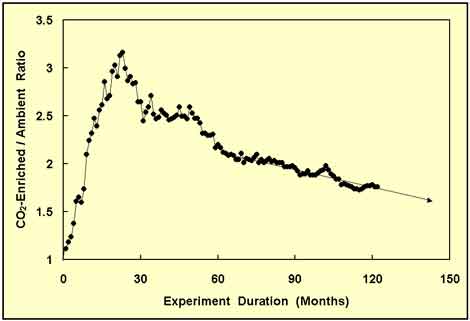Volume 11, Number 47: 19 November 2008
In an Associated Press news release dated 11 November 2008, Jeff Barnard relates how "following the advice of a specially convened panel of experts," the U.S. Department of Energy (DOE) has notified the managers of the country's three major forest FACE (free-air CO2-enrichment) experiments that their current research must be "phased out by 2011," and that they are to quickly acquire the "definitive measurements" on how the trees they are studying have responded to close to a decade of exposure to elevated atmospheric CO2 concentrations, so that a new set of experiments can be begun in 2012.
One of the chief goals of the FACE experiments is to determine the long-term response of earth's trees to the ongoing rise in the air's CO2 content, particularly with regard to their ability to remove carbon dioxide from the atmosphere and sequester it in their trunks, branches and roots, as well as in the soil in which they grow, in order to determine the degree to which the planet's forests may mitigate the global warming that climate models ascribe to the "greenhouse" properties of CO2.
"What we are trying to do here is balance the time to get optimal results out of the existing experiment," said a program manager with the DOE. Many of the scientists actually engaged in the research, however, are more concerned about getting the right results. And so they should be, for the truth of the matter will likely take considerably more time to ferret out than what the DOE's experts claim it will.
A case in point is provided by the long-term sour orange tree experiment carried out at the U.S. Water Conservation Laboratory in Phoenix, Arizona (Idso and Kimball, 2001; Kimball et al., 2007). As is indicated by the figure below, if that experiment had been terminated at the ten-year point of the study, we would have predicted that the CO2-induced growth enhancement would have gradually dwindled away to next to nothing in another decade or so, based on the well-defined linear decline in CO2-induced growth enhancement that was observed over the last five years of the experiment to that point in time.

Figure 1. The CO2-enriched/ambient-treatment ratio of total aboveground sour orange tree wood biomass plotted as a function of time since the start of the experiment, along with an arrow that depicts what would seem to be the logical projection of what would happen to this ratio if the experiment were to be continued beyond the last point shown.
However, by continuing the study for several more years, as shown in the figure below, the extra data thereby obtained suggested a very different long-term equilibrium result.

Figure 2. Same as Figure 1, but with 60-plus months of additional data and a new projection of the wood biomass ratio.
Clearly, there is no way of knowing in advance how the results of additional data will affect the outcome of a long-term tree experiment; and for a "panel of experts" (none of whom has ever conducted such a study) to believe they can mandate the collection of "definitive measurements" required for "optimal results" over the next couple of years -- especially in the case of the long-term forest FACE studies they are targeting for closure -- is ludicrous. One simply does not know what the long-term holds until one gets there; and the three FACE studies the DOE is seeking to terminate may still have a long way to go in order to acquire the knowledge we are seeking. To cut off their funds at this point in time would be nothing short of a crime. We therefore plead for the responsible DOE officials to reconsider their decision.
Sherwood, Keith and Craig Idso
References
Idso, S.B. and Kimball, B.A. 2001. CO2 enrichment of sour orange trees: 13 years and counting. Environmental and Experimental Botany 46: 147-153.
Kimball, B.A., Idso, S.B., Johnson, S. and Rillig, M.C. 2007. Seventeen years of carbon dioxide enrichment of sour orange trees: final results. Global Change Biology 13: 2171-2183.




